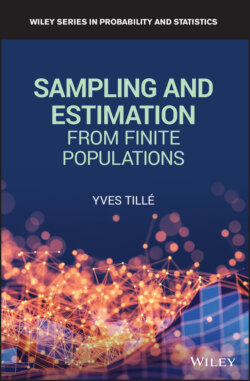Читать книгу Sampling and Estimation from Finite Populations - Yves Tille - Страница 40
2.5 Estimation of a Total
ОглавлениеFor estimating the total
the basic estimator is the expansion estimator:
This estimator was proposed by Narain (1951) and Horvitz & Thompson (1952). It is often called the Horvitz–Thompson estimator, but Narain's article precedes that of Horvitz–Thompson. It may also be referred to as the Narain or Narain–Horvitz–Thompson estimator or ‐estimator or estimator by dilated values.
Often, one writes
but this is correct only if , for all If any inclusion probabilities are zero, then is divided by 0. Of course, if an inclusion probability is zero, the corresponding unit is never selected in the sample.
In this estimator, the values taken by the variable are weighted by the inverse of their inclusion probabilities. The inverse of is often denoted by and can be interpreted as the number of units that unit represents in the population. The value is the weight assigned to unit The expansion estimator can also be written as
